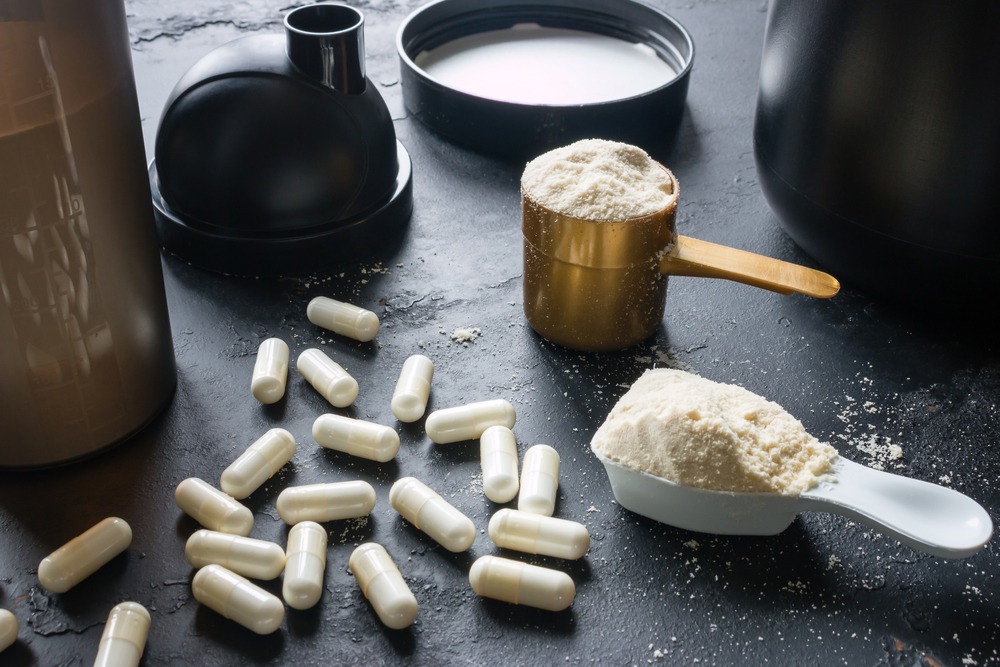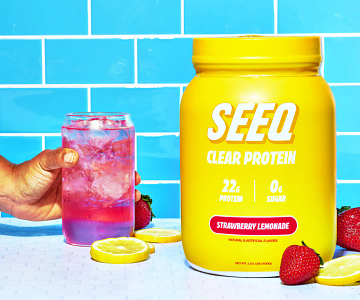- Fact Checked
Last Updated: August 18, 2022
Beta-alanine vs. creatine: what’s the difference? Both are similar in the sense that they’re amino acids. The human body creates both on its own, which can also be acquired through food consumption or as supplements.
However, there are some fundamental key differences between beta-alanine and creatine, including how each amino acid is produced within the body, how you take them as supplements, and their benefits.
We’ll take a closer look at them in this article, starting with a breakdown of beta-alanine and its pros and cons, followed by a breakdown of creatine and its pros and cons. Then we’ll compare them and answer some common questions about them.
Beta-alanine (β-Alanine) is a non-proteogenic (not capable of producing proteins) amino acid produced endogenously in the liver. It’s one of the main components of carnosine, a naturally occurring histidine-containing compound found predominantly in skeletal muscle.
Humans acquire small amounts of beta-alanine through consuming foods like poultry and red meat. The liver also creates about one gram of beta-alanine per day.
On its own, beta-alanine properties are limited. But, the availability of beta-alanine dictates carnosine levels. So, beta-alanine is the rate-limiting precursor to carnosine synthesis.
For this reason, supplementing with carnosine alone is not as beneficial as beta-alanine alone. When taken orally, carnosine breaks down during digestion into its components: histidine and beta-alanine. Thus, only a portion of that carnosine taken orally is beta-alanine. This is why supplementing with beta-alanine on its own has more benefits.
Beta-alanine works by increasing concentration levels of carnosine within the skeletal muscle. Increased levels of carnosine in the body are advantageous as a supplement for athletes who wish to improve their training performance and see more significant gains. Additionally, carnosine helps prevent chronic diseases like diabetes, atherosclerosis, and cognitive impairment.
You can purchase beta-alanine singularly as a supplement or as part of the formula for a pre-workout supplement.
Supplementing with beta-alanine can lead to many benefits. For example, minimal fatigue during exercise, enhanced neuromuscular performance, and reduced oxidative stress are a few advantages.
Another benefit of beta-alanine is its use in a topical skin cream. Creams containing this supplement can help reduce the appearance of wrinkles in aging skin.
There aren’t many negatives to supplementing with beta-alanine. The most noted side effect is a tingling sensation or paresthesia. Those who take the beta-alanine supplement may experience a “pins and needles” feeling on the face, arms, or legs soon after consumption, which can feel a little strange. However, it dissipates over time, especially once you get used to it.
In addition to the tingling, you may also experience a flushing or burning sensation or a prickly/itchy feeling. However, you can avoid paresthesia by taking a lower dosage of the beta-alanine supplement or using a supplement with a sustained-release formula.
This side effect is typically no cause for concern so long as it subsides by the time you’ve finished your workout. However, if you are continually experiencing these sensations, it may be best to stop taking the beta-alanine supplement and contact your doctor.
Another known side effect of supplementing with beta-alanine, which could be more inconvenient than the tingling, is muscle cramping. Too much beta-alanine can result in insufficient taurine levels; taurine is known to prevent muscle cramping. Thus, over-consumption of beta-alanine could result in excessive, painful muscle cramps.
The beta-alanine supplement can be purchased in powder form and added to your favorite smoothie. Alternatively, you can mix the powder with water, almond milk, or juice. If powder form isn’t your speed, the beta-alanine supplement is also available in capsule form. Check out your local vitamin shop for more options.
The International Society of Sports Nutrition (ISSN) recommends supplementing with four to six grams of beta-alanine daily. Beta-alanine is most advantageous when taken in small doses of two grams or less throughout the day to total four to six grams.
Dosages of four to six grams per day have been proven to increase carnosine concentrations in the muscle by up to 64% after at least four weeks of continuous use. But you should allow for a minimum of two to four weeks of consistent supplementation before you can expect to see major effects.
Two to four consecutive weeks of daily supplementation (at four to six grams daily) is proven to augment muscle carnosine concentrations, essentially acting as an intracellular pH buffer. This means that beta-alanine works to reduce lactic acid buildup in the active muscles during high-intensity exercise.
Consistent supplementation of beta-alanine for at least two weeks has been shown to improve exercise performance, most of its advantages for timed intervals of one to four minutes.
Beta-alanine can also reduce neuromuscular fatigue, specifically in older users, and may improve tactical performance.
Combining beta-alanine with other single or multi-ingredient supplements may be beneficial so long as the supplementation of beta-alanine is high enough (at least four to six grams daily) and is taken long enough (at least four weeks).
More thorough testing is needed to determine if beta-alanine affects strength or endurance performance longer than twenty-five minutes and if there are any other health-related benefits associated with carnosine.
BulkSupplements offers a great beta-alanine supplement in powder form. Each serving, roughly ¼ teaspoon, contains 600 milligrams of beta-alanine. The company recommends taking this supplement three times a day, or as directed by your physician.
BulkSupplements notes that this supplement supports muscle recovery and endurance and will help you increase carnosine levels and build lean muscle mass. This product currently has a 4.6-star rating (out of 9,842 ratings and reviews) on Amazon.
Creatine is an amino acid found predominantly in the muscles and the brain. Ninety-five percent of creatine is stored in the skeletal muscles and used during physical activity, and the remaining five percent is in the brain.
Creatine helps the body maintain a continuous supply of energy for working muscles. It’s a natural energy source for muscle contraction and advantageous for strength, muscle size, and performance.
The liver, pancreas, and kidneys naturally create about one to two grams of creatine per day. Humans can also acquire one to two grams of creatine by eating seafood, red meat, and milk — but at much lower levels than synthetic creatine supplements can provide. Those who do not consume meat or dairy products, like vegetarians and vegans, may naturally have lower amounts of creatine in their bodies.
You can purchase creatine singularly as a supplement or as part of the formula for a pre-workout supplement.
Oral creatine supplementation may be advantageous for strength, muscle size, and performance. This is because the supplement allows athletes to do more work during reps or sprints, leading to more significant strength gains, muscle mass, and higher performance.
Because creatine increases water retention in the muscles, supplementing with it can help prevent injury often caused by dehydration, muscle cramping, or injuries to the muscles, bones, ligaments, tendons, and nerves.
Creatine also benefits cognition and brain health, especially in older individuals. Additionally, it can help counteract age-related declinations in skeletal muscle and bone mineral density.
Vegetarians and vegans benefit most from creatine supplementation since they have lower levels of creatine occurring naturally within their bodies.
Though creatine comes with many benefits, it has its disadvantages too. Weight gain (typically as lean body mass) is among the most common effects of creatine supplementation and could be an issue for those who want to see the number on the scale decrease.
It can take anywhere from seven to twenty-eight days to see energy effects, depending on how much creatine your body already has.
It can be potentially dangerous to take creatine supplements when you are dehydrated or disadvantageous if you are trying to lose weight. Creatine can be especially dangerous for those with pre-existing kidney problems, but there isn’t currently much research on that account.
If you’re a caffeine addict, you may have an issue receiving the full benefits of creatine supplementation; the combination of creatine and caffeine can reduce the overall effects of creatine.
Using creatine while consuming more than 300 milligrams of caffeine per day can also worsen the progression of Parkinson’s disease, but further research is needed to determine the true effects.
It’s recommended to undergo a creatine loading phase of twenty to twenty-five grams every four hours, daily, for about five to seven days. After that period, you should consume about three and a half grams daily as a maintenance dose.
During the loading phase, it’s important to note that body weight may increase by nearly 2% due to the increased water retention in the muscles.
While the loading phase for creatine can be helpful, it’s not necessary to reap the benefits so long as you take creatine consistently, so you can choose what works best for your lifestyle.
Creatine HMB, by Transparent Labs, is a powder form creatine supplement offered in several flavors. It’s recommended to take one scoop (about seven grams) with four to six ounces of water, juice, or protein within thirty minutes after your workout session. You should take one scoop of creatine in the morning on your rest days for optimal recovery.
Though there are many similarities between these two amino acids, there are even more differences. Depending on your supplementation goal, you may desire one over the other or a combination of both. 
The most obvious similarity between beta-alanine and creatine is that they’re both amino acids. Both are used as supplements by athletes to enhance performance during high-intensity, intermittent training, or HIIT, and are typically found in pre-workout supplements.
That’s not to say that athletes engaging in different exercises don’t use these supplements as well. Still, research has shown that you reap the most benefits of these supplements while engaging in exercise with interval durations of one to four minutes.
Beta-alanine and creatine are absorbed into the body through the consumption of red meat. Both amino acids are nonessential, as they can be produced within the body naturally.
In addition to benefits for exercise performance, beta-alanine and creatine are both used in topical skin creams (along with other ingredients) to help reduce skin sag and wrinkles and improve sun-damaged skin.
There are quite a few differences between these two amino acids. Beta-alanine is produced in the liver during the catabolism of uracil (a nucleotide base compound in RNA). After it’s been released into plasma, it’s transported to the tissues that require it for carnosine synthesis. In addition to red meat, beta-alanine can also be acquired through the consumption of poultry.
Alternatively, creatine is made up of three amino acids: L-arginine, glycine, and L-methionine. Once it has been converted for use by the liver, kidneys, and pancreas, creatine is transported through the blood to the parts of the body that have high energy needs; primarily the skeletal muscle and the brain.
Just like beta-alanine can be acquired through the consumption of poultry, creatine can also be absorbed from seafood.
Aside from performance benefits, creatine treats certain brain disorders, neuromuscular conditions, and congestive heart failure.
Another notable difference between beta-alanine and creatine is the dosage recommendations.
Typically, you should take four to six grams of beta-alanine per day, ideally divided up into portions of two grams or less. With creatine, you’ll typically want to take your three and a half grams post-workout or in the morning on your rest days.
Beta-alanine and creatine are commonly known within the fitness industry for their benefits to performance and strength. But many don’t know exactly where these amino acids come from or what exactly they do.
Check out some of the most commonly asked questions.
Beta-alanine is a non-proteogenic amino acid produced endogenously in the liver. It’s one of the main components of carnosine and can be acquired through the consumption of poultry and red meat.
Creatine is an amino acid found predominantly in the muscles and the brain. It helps the body maintain a continuous supply of energy for working muscles and can be acquired through the consumption of seafood and red meat.
Either one — it’s your choice. Depending on your fitness and health goals, you can benefit from supplementing with either beta-alanine or creatine. Both have proven benefits to enhance your workouts and help you meet your fitness goals.
Yes. You can benefit greatly from supplementing with both beta-alanine and creatine. One works to reduce fatigue and lactic acid buildup in your muscles during workouts, and the other helps you to feel more energized and conditioned in your training.
Yes. It’s recommended that you take four to six grams of beta-alanine per day. It’s most advantageous when taken in small doses of two grams or less throughout the day to total four to six grams. You should wait for a minimum of two to four weeks of consistent supplementation before you can expect to notice major benefits regarding your workout performance.
Yes. While not necessary, it’s recommended that you undergo a creatine loading phase of twenty to twenty-five grams every four hours daily for about five to seven days.
After that period, you should consume about three and a half grams daily as a maintenance dose.
This answer will depend on you and your fitness goals. Beta-alanine reduces fatigue and lactic acid buildup in your muscles, while creatine supports short, intense bursts of power. So if you’re looking for assistance with muscle cramps and tiredness, beta-alanine is the way to go. If you’re looking to feel stronger and more conditioned in your workouts, creatine is a good choice.
The best option would be to supplement with both beta-alanine and creatine.
Ultimately, there are some fundamental differences between beta-alanine vs. creatine. However, both of them are non-essential amino acids that can prove useful in your fitness journey.
You might want to use one over the other, depending on what kind of supplementation you’re looking for, or whether you want to take something before or after your workouts. Of course, you can also try adding them both to your supplementation routine, since they each bring something new to the table to help maximize your gains.


Address: 1300 Avenida Vista Hermosa, San Clemente, CA 92673, United States | Phone Number: +1 (949) 248-0131 | Email: contact@veganliftz.com